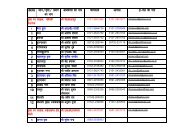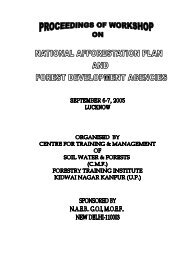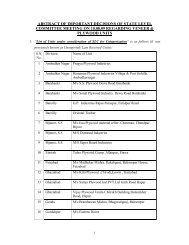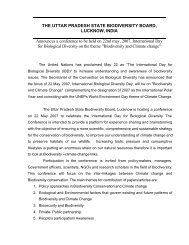903048B 7yrbuspln - U.P. Forest Department
903048B 7yrbuspln - U.P. Forest Department
903048B 7yrbuspln - U.P. Forest Department
You also want an ePaper? Increase the reach of your titles
YUMPU automatically turns print PDFs into web optimized ePapers that Google loves.
History of ISIS<br />
ISIS began in 1973 when Professor Ulysses S. Seal and a small group of veterinarians, scientists and<br />
zoo leaders developed a vision for a global animal information system that would serve zoos and<br />
aquariums. In the beginning, the Minnesota Zoological Garden generously served as the “enterprise<br />
incubator” for ISIS. The American Zoo & Aquarium Association (AZA), the American Association of<br />
Zoo Veterinarians (AAZV) and other zoological associations provided grants and encouragement.<br />
ISIS began operations in 1974 with 55 member institutions (mostly in North America) and an<br />
international vision, mission and name. Through 30 years, membership has grown at an average of<br />
20 new institutional members per year, and expanded globally. Currently, ISIS has 630 members in<br />
more than 70 countries on six continents. In 2004 alone, 50 new members joined ISIS.<br />
In 1989, ISIS transformed from a self-funded department of the Minnesota Zoological Garden into<br />
an international, member-owned, non-profit organization governed by the internationally elected<br />
ISIS Board of Trustees. (See Appendix A for a list of current ISIS Board members.)<br />
The history of ISIS can be seen as a 30-year “proof of concept.” ISIS staff has often been told “global<br />
cooperation cannot be done.” Nevertheless, it IS being done! Through a mix of internal development<br />
and outsourcing, ISIS has supported four generations of software for worldwide animal inventory,<br />
veterinary record keeping, studbook applications and other uses, used by a steadily growing global network.<br />
ISIS has played a key role in establishing standards and sharing globally pooled specimen records<br />
among the zoo and aquarium community. ISIS has helped zoos and aquariums cooperate more than<br />
comparable organizations, like botanical gardens and museums, in data management, software<br />
development and global data sharing. This has many advantages, and has saved ISIS member<br />
institutions the very considerable costs of developing such tools individually.<br />
While the ISIS membership network has continuously expanded, limited ISIS resources have<br />
slowed technical progress. For most of the history of ISIS, there has been one staff person for about<br />
50 institutions served. This thrifty approach kept costs down, but at times in the past resulted in<br />
long waits for technical service, inadequate training and restricted services.<br />
The majority of the organization’s resources come from member dues, which now total US $1.4 million<br />
per year, but were less than US $1 million annually before 2004. ISIS has relied substantially on more<br />
than 70 grants and contracts, which have been generated by the organization’s small staff.<br />
(A partial list of these grants is printed in Appendix C.)<br />
Now, rapid advances in information technology offer enormous opportunities to carry the ISIS mission<br />
further, serving the global zoo and aquarium community and wildlife conservation through effective,<br />
current information sharing. Hence, ISIS has restructured its Board of Trustees, strengthened its internal<br />
management team, and expanded and professionalized user technical support, adding essential staff<br />
capacity to manage the Zoological Information Management System (ZIMS) Project.<br />
ISIS is committed to further changes as needed to serve its members. As one measure of these changes,<br />
there is now one ISIS staff person per 30 institutional members – improving the level of service ISIS provides.<br />
To pay for these essential changes, the ISIS Board approved a restructured member dues schedule effective<br />
from 2004. In addition, ISIS is conducting a capital campaign Building ZIMS: The Campaign for ISIS to<br />
raise funds for development and deployment of ZIMS.<br />
4-5

















